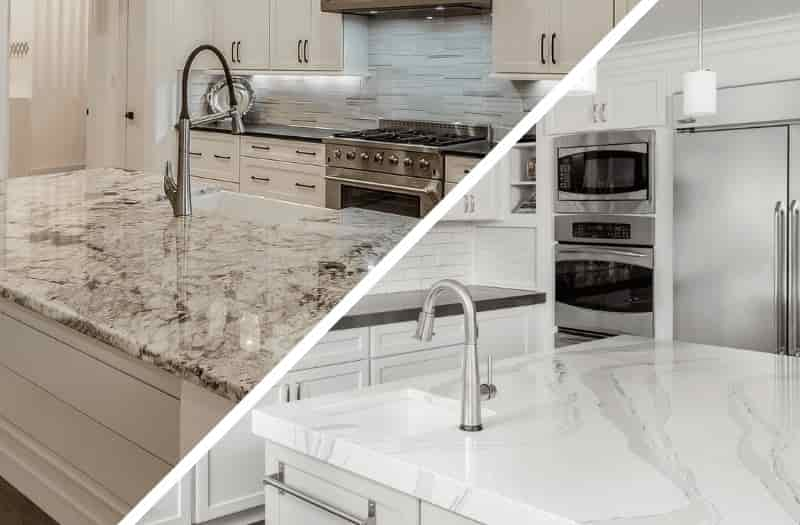Marble vs. Granite: Which Stone is Right for Your Project?
Marble vs. Granite: Which Stone is Right for Your Project?
When it comes to selecting the perfect stone for your project, whether it’s a kitchen countertop, bathroom vanity, or flooring, two materials often stand out: marble and granite. Both are natural stones, known for their beauty and durability, but they offer distinct characteristics that can make one more suitable than the other depending on your needs. In this blog, we’ll compare the benefits, aesthetics, and applications of marble and granite, helping you make an informed decision.Marble vs. Granite: Which Stone is Right for Your Project?
1. Aesthetic Appeal
Marble
Marble is synonymous with luxury and elegance. Known for its smooth texture and unique veining patterns, marble has been used for centuries in art and architecture. Its classic beauty makes it a popular choice for high-end interiors, adding a touch of sophistication to any space. Marble typically comes in lighter colors, such as white, beige, and grey, with striking veins of contrasting colors like gold, black, or green.
Example: Imagine a bathroom with a white Carrara marble vanity—its subtle grey veining adds a timeless elegance that few other materials can match.
Granite
Granite, on the other hand, offers a more diverse range of colors and patterns. From deep blacks and blues to vibrant reds and greens, granite can be found in almost any hue. Its speckled appearance, caused by the presence of various minerals, gives granite a more dynamic and textured look. This makes granite ideal for adding visual interest to any room, whether in a modern or traditional setting.
Example: A kitchen island with Black Galaxy granite becomes a focal point, with its dark base and sparkling specks of gold and white creating a captivating contrast.
 2. Durability and Maintenance
2. Durability and Maintenance
Marble
While marble is undoubtedly beautiful, it is also softer and more porous than granite. This means it can be more susceptible to scratches, stains, and etching from acidic substances like lemon juice or vinegar. To maintain its appearance, marble requires regular sealing and careful cleaning with pH-neutral cleaners.
Key Point: If you’re considering marble for high-traffic areas or spaces prone to spills, be prepared for more maintenance to keep it looking pristine.
Granite
Granite is one of the hardest natural stones, making it incredibly durable and resistant to scratches, heat, and stains. Once sealed, granite requires minimal maintenance, making it a practical choice for busy kitchens and bathrooms. Its resistance to wear and tear ensures that granite surfaces can withstand daily use without losing their luster.
Key Point: For homeowners who prioritize durability and low maintenance, granite is often the preferred choice.
3. Applications
Marble
Marble is often used in spaces where aesthetics are the top priority. Its luxurious appearance makes it ideal for bathroom vanities, fireplace surrounds, and accent walls. Marble can also be used for flooring, particularly in areas where a high-end, polished look is desired.
Example: A marble fireplace surround can serve as a stunning centerpiece in a living room, adding warmth and elegance to the space.
Granite
Granite’s versatility and durability make it suitable for a wide range of applications. It is commonly used for kitchen countertops, bathroom vanities, and flooring. Granite can also be employed for outdoor applications, such as patio surfaces or outdoor kitchen countertops, due to its resistance to weathering.
Example: A granite countertop in an outdoor kitchen provides both durability and beauty, withstanding the elements while maintaining its aesthetic appeal.
4. Cost Considerations
Marble
Marble tends to be more expensive than granite, especially if you opt for high-end varieties like Calacatta or Statuario. The cost of marble can be a significant factor when choosing a material, particularly for large projects. However, for those looking for that timeless, luxurious look, the investment in marble can be well worth it.
Granite
Granite is generally more affordable than marble, with prices varying based on color, pattern, and origin. Its cost-effectiveness, combined with its durability, makes granite a popular choice for homeowners looking to balance aesthetics with budget considerations.
5. Resale Value
Both can add value to your home, but in different ways. Marble is often seen as a luxurious, high-end material, which can attract potential buyers looking for premium features. Granite, being more durable and practical, appeals to a broader range of buyers who appreciate both beauty and functionality.
Conclusion: Which Stone is Right for Your Project?
Choosing between marble and granite ultimately depends on your priorities. If you value elegance, luxury, and are willing to invest in maintenance, marble might be the right choice for your project. On the other hand, if durability, ease of care, and a wider variety of colors are more important to you, granite could be the better option.
Consider the specific needs of your space, your aesthetic preferences, and your budget when making your decision. Both are excellent choices, each offering unique benefits that can enhance the beauty and functionality of your home.
